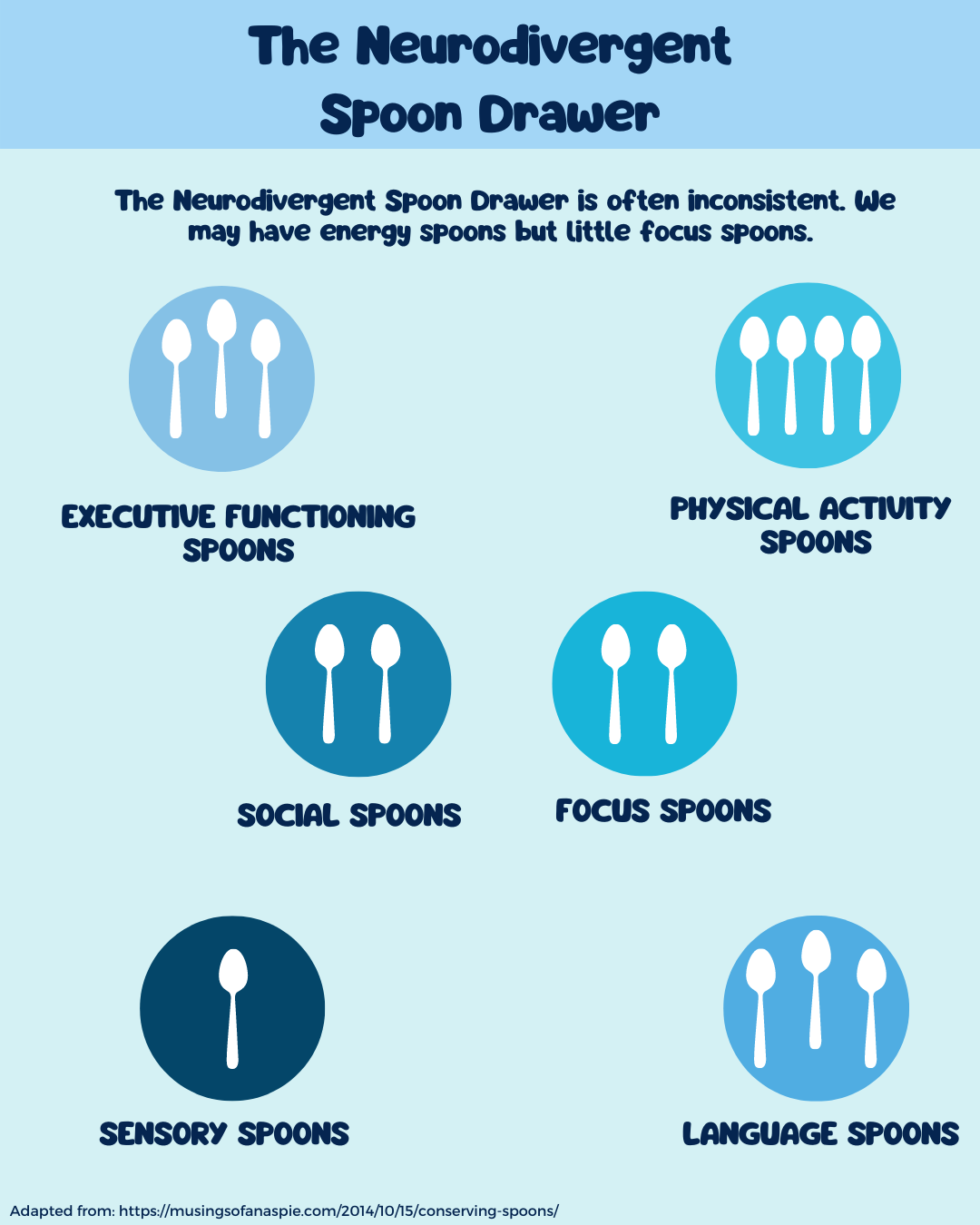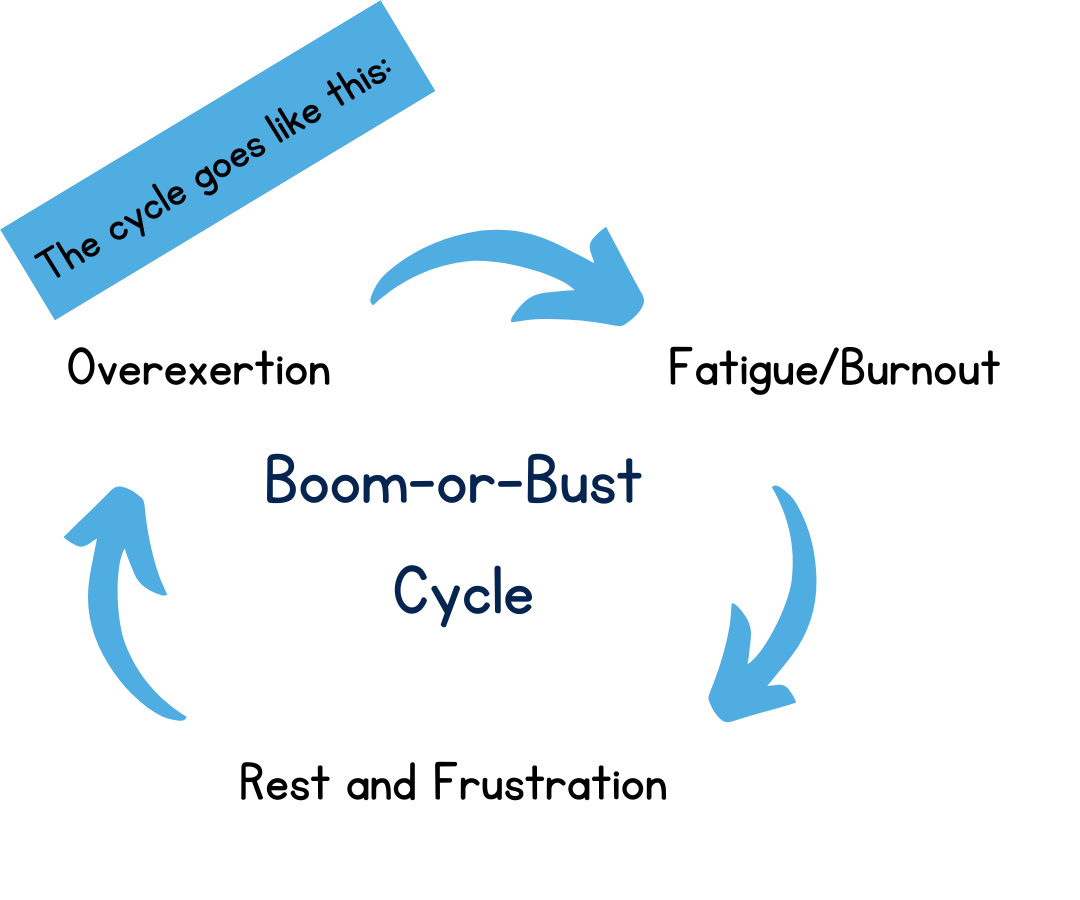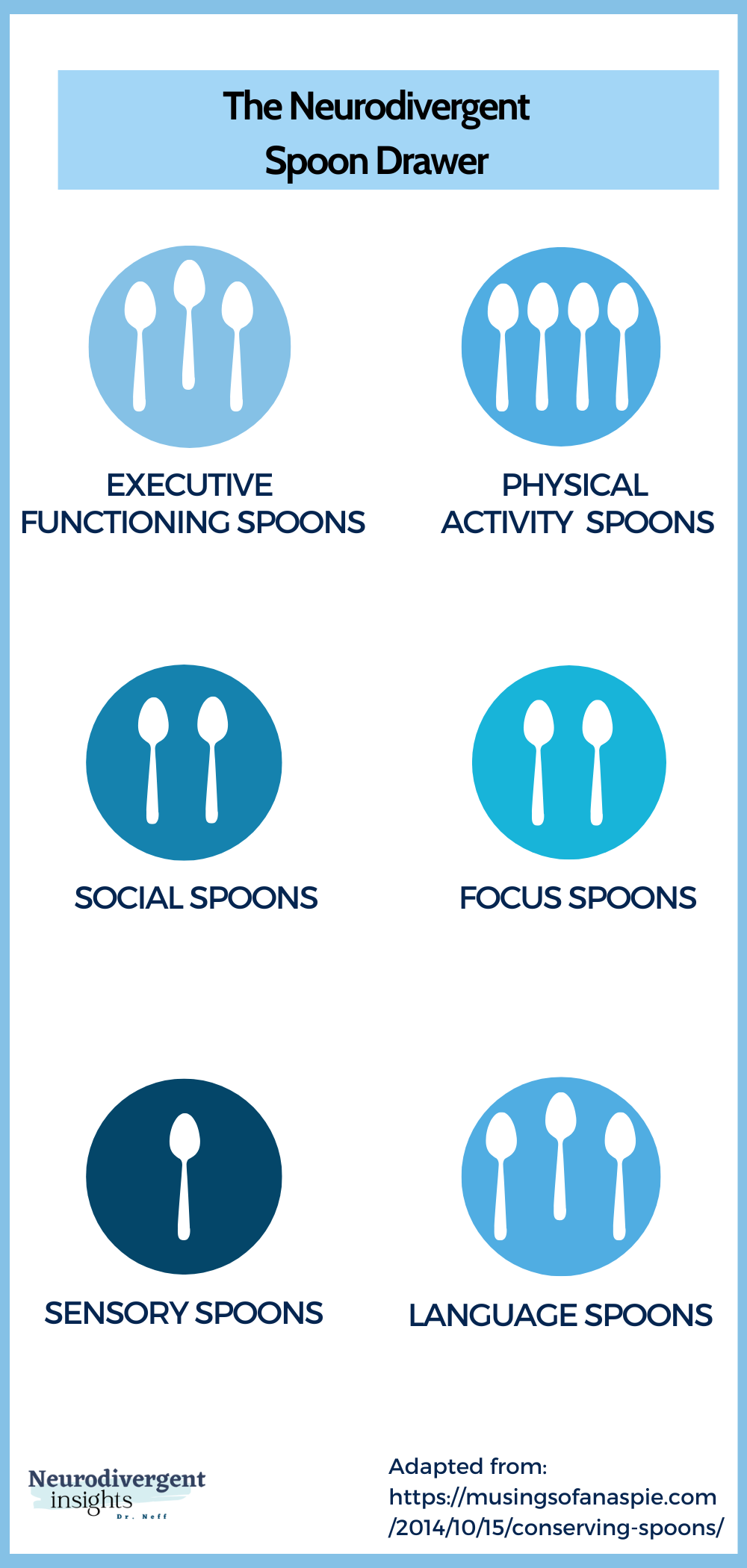Spoon Theory For Autism and ADHD: The Neurodivergent Spoon Drawer
Spoon Theory for Autism and ADHD
Why a Neurodivergent Spoon Theory?
Chronic fatigue and burnout are less commonly talked about in ADHD and Autistic experiences. Many Autists and ADHDers deal with things like chronic fatigue, burnout, and chronic pain. Several factors contribute to this (co-occurring medical issues, sensory overload, over-exerting ourselves, navigating a world not designed for us, and more). One of the things that perpetuate these patterns is something called the "Boom-or-Bust" Cycle. Many Autistic and ADHD individuals, as well as those with chronic illnesses, experience the "boom-or-bust cycle.”
What is the Boom-or-Bust Cycle?
First, it is helpful to note that everyone falls into the boom-or-bust cycle to some degree. The boom-or-bust cycle happens when we over-extend ourselves on good days and then need to recover the following day. This isn't a big deal for healthy people as they can easily bounce back.
The boom-or-bust cycle is a common experience for people living with a chronic health condition, fatigue, pain, or disability. On good energy days, it feels so good to accomplish things, we may feel as if we are trying to make up for lost time. So we may over-extend ourselves while overriding our body's signals and push our bodies beyond its limits. This is then inevitably followed by a "crash." ADHDers and Autistic people often overextend themselves--failing to honor their limits in our effort to "push through." This is often followed by a crash (burnout), and then rinse and repeat, and each time we whirl through this cycle, we sink into a deeper form of burnout.
The Downward Spiral
This pattern becomes problematic when it becomes a lifestyle that leads to burnout. Below are a few of the problems associated with this cycle:
1) When we perpetually push ourselves beyond our body's limit, it takes longer to recover each time we go through the cycle, and the burnout deepens.
2) It tends to send our mood on a rollercoaster. We tend to feel upbeat, positive, and accomplished on our "good" days, followed by a collapsing depression, disappointment, and melancholy on our "recovery days."
3) Each time we go through the cycle, it takes us longer to get back to our baseline, which is how we end up in positions of chronic pain, fatigue, and burnout.
The following graph illustrates the boom-or-bust cycle. You'll notice that the rest time between each cycle extends, and it takes a person longer and longer to return to their baseline. The red line illustrates the downward fatigue spiral that occurs. The green line represents a steady energy expenditure that is more sustainable and enduring. Pacing systems is one of the things that helps a person get out of the boom-or-bust cycle and to move toward a more sustainable energy rhythm.
Intro to Pacing Systems
Several practices help us get off the boom-or-bust rollercoaster:
addressing internalized ableism
practicing good boundaries
prioritizing healthy sleep habits and more
I also find that pacing systems are a helpful tool for breaking the boom-or-bust cycle. Pacing systems intervene with the boom-or-bust cycle by creating a system to have a more balanced expenditure of energy throughout so that we don't have as extreme of crashes.
I first learned about pacing systems when working as a therapist in an oncology clinic and working with patients going through treatment. Pacing their activities was vital for their energy, pain, and more.
Pacing systems are widely used in medical systems for people experiencing chronic pain, chronic fatigue, and other challenges related to a disability or chronic health issue. A pacing system is essentially any system that helps you sustainably monitor and manage energy. Spoon theory is one of my personal favorite pacing systems!
When it comes to spoon theory for autism and ADHD, the tool can be a helpful way to understand and communicate and advocate for our needs. Spoon theory is a pacing system, and can help us to prevent burnout by helping us to evenly distribute our energy.
What is Spoon Theory?
Spoon theory was birthed in a college diner where Christine Miserandino shared a meal with her friend. Her friend inquired about what it was like to live with a chronic medical condition. Christine grabbed all the spoons nearby and handed them to her friend.
She told her friend---"most people wake up with an endless supply of spoons, but here, for this experiment, you have 12". She asked her friend to walk her through her day. For each activity (waking up, showering, getting dressed), Christine took a spoon away.
Christine used this metaphor to explain that when she wakes up, she has a limited number of spoons. She must be meticulous about every choice she makes. Living with a chronic illness means she must always be aware of how much energy she had and what activities she would "spend her spoons" on any given day.
Christine has since used this theory in the context of disability advocacy. It has become a powerful metaphor for explaining how people with chronic illness, fatigue, or a disability must be acutely aware of their energy units.
You can read about the experience in her own words in her blog post.
Autism and ADHD Adapted Spoon Theory
The concept of "spoons" as a metaphor for energy reserves is popular but can be a bit vague, especially for neurodivergent individuals. Energy isn't distributed equally across all activities for everyone. For example, you might have plenty of physical energy one day but struggle with tasks that need high focus, or vice versa. This can lead to conflicting needs, like wanting to socialize but being limited by sensory overload.
Understanding these nuances, autistic author and advocate Cynthia Kim suggested a more tailored approach for neurodivergent individuals. She proposed different types of "spoons" for various functions—like mental energy, focus, or executive functioning—that can vary independently from one another.
The Neurodivergent Spoon Drawer is often inconsistent. We may have plenty of energy spoons but few focus spoons, or social spoons but limited sensory spoons. Our spoons can live in conflict and create tension for us.
The inconsistency in our energy spoons can cause our actions to be misinterpreted. Such as, "If you have the energy to see your friends, you certainly have the energy to do your homework!"
The inconsistency in our energy can be a source of frustration for us and those closest to us. For example, for me:
I have lots of mental spoons and very low social spoons, sensory spoons, and physical energy spoons.
I can write a workbook a month, create IG content, etc., with ease. But send me to a child’s birthday party or the grocery store, and I will need some serious recovery time!
Our “spikey” energy units can often be misinterpreted. Having a “spikey spoon drawer” can be interpreted as being selfish or lazy (“you have time for the things you want to do but not the things you NEED to do,” and so on).
So for the ADHDer and Autistic person, it’s helpful to go beyond thinking about how many global spoons we have. And to consider how many spoons we have in a specific area (executive functioning, sensory, social, and so on).
Being able to talk about the Neurodivergent spoon drawer can help us to better communicate about our experiences and needs. I will also use my awareness of my various spoons to motivate myself. For example, I may pair an activity that requires a high level of spoons (cleaning the bathroom) with something that recharges my energy (listening to a podcast that covers an area of special interest).
*The concept of applying spoon theory for neurodivergence is not original to me; I first learned about this while reading musingsofanaspie's writing on this.
This post was proofread by Grammarly, my go-to for proofreading and catching all the details I naturally miss! Grammarly is entirely free to use. Click here to give it a try.






